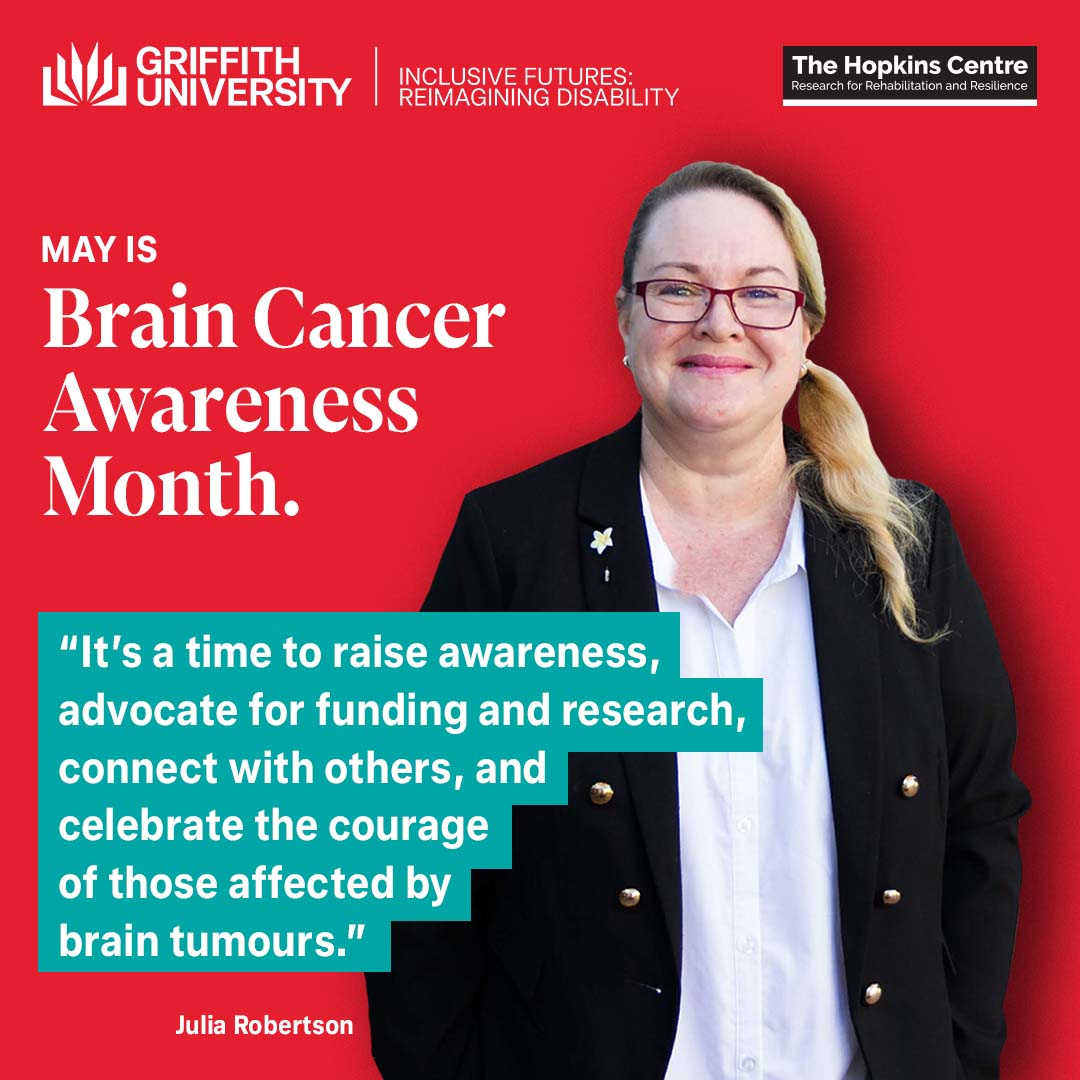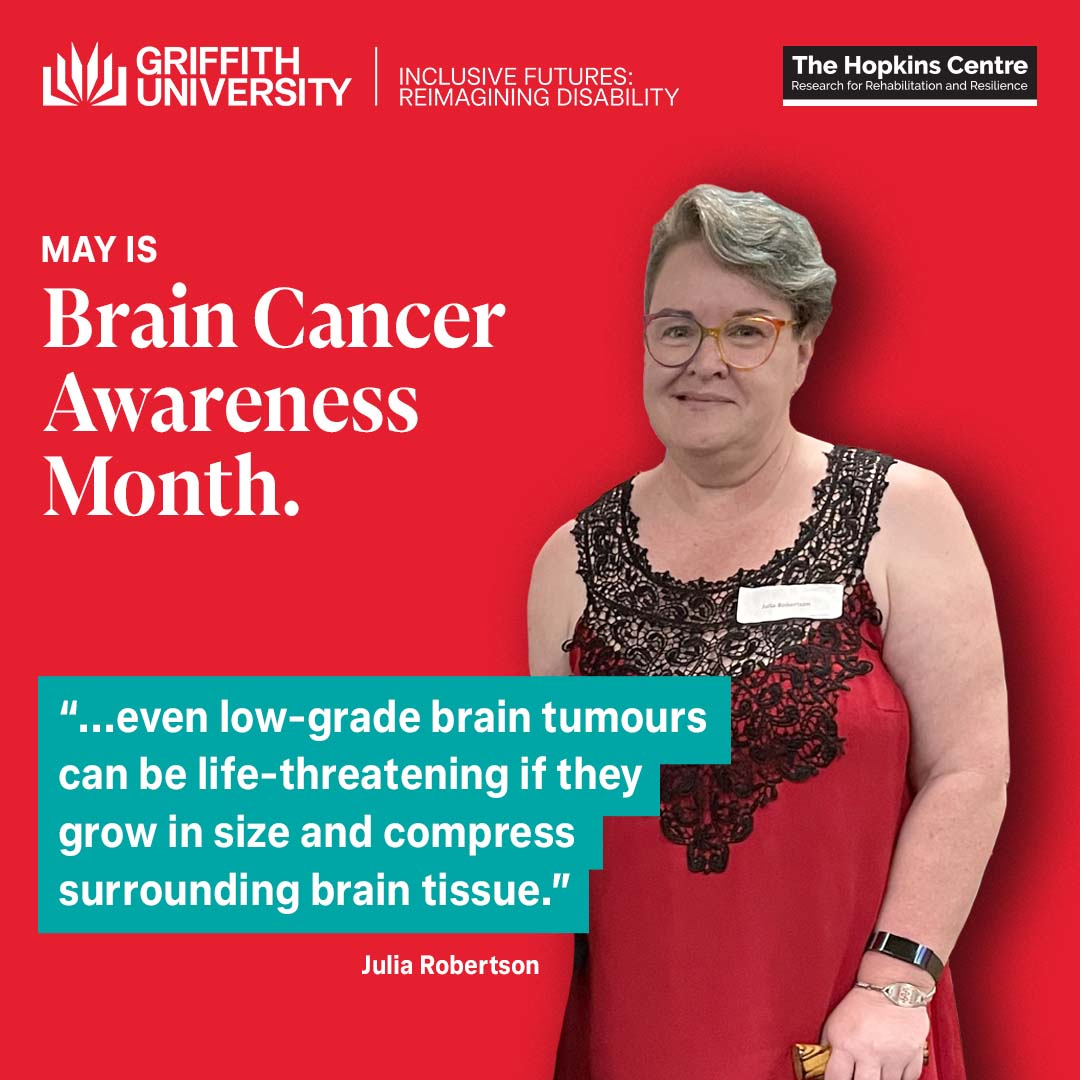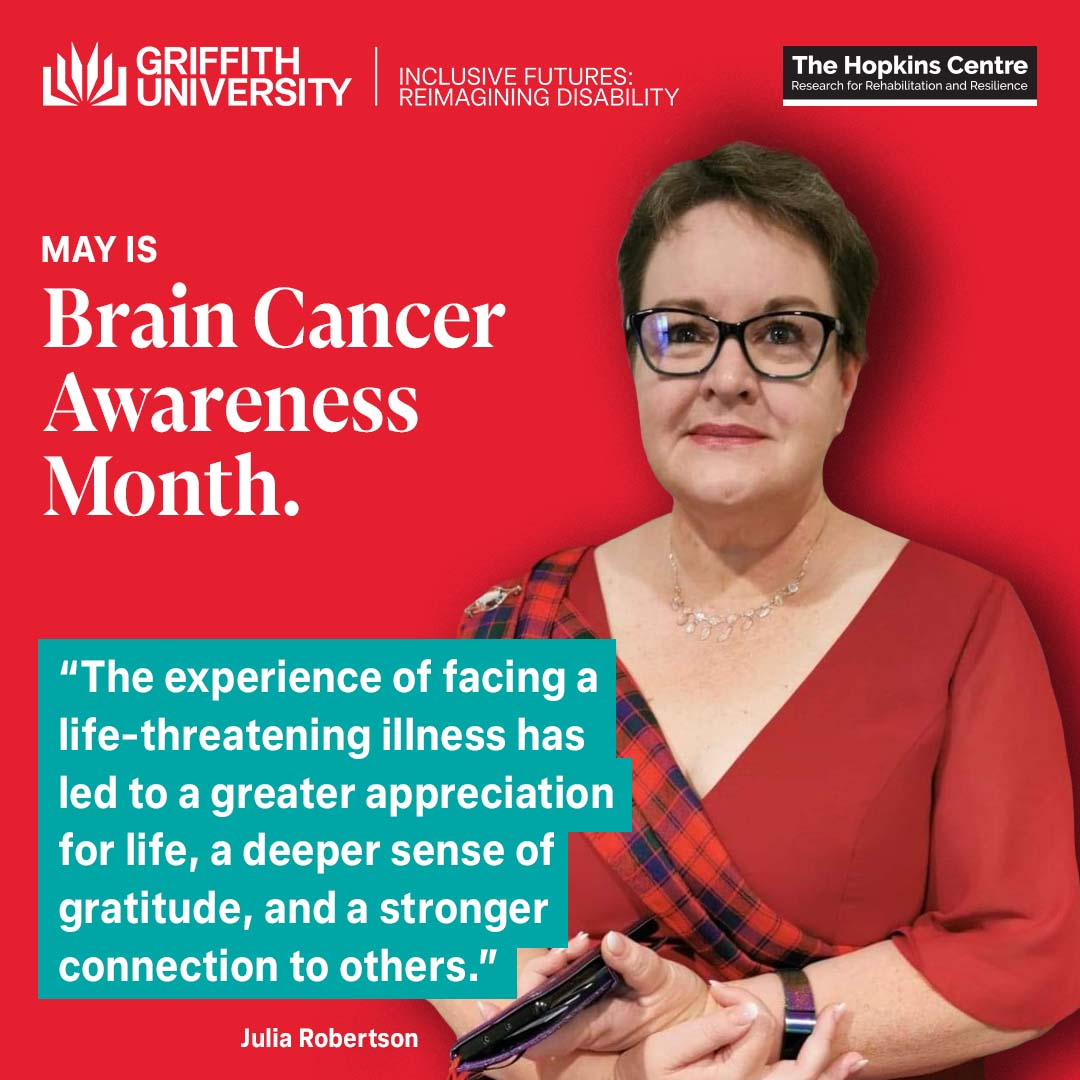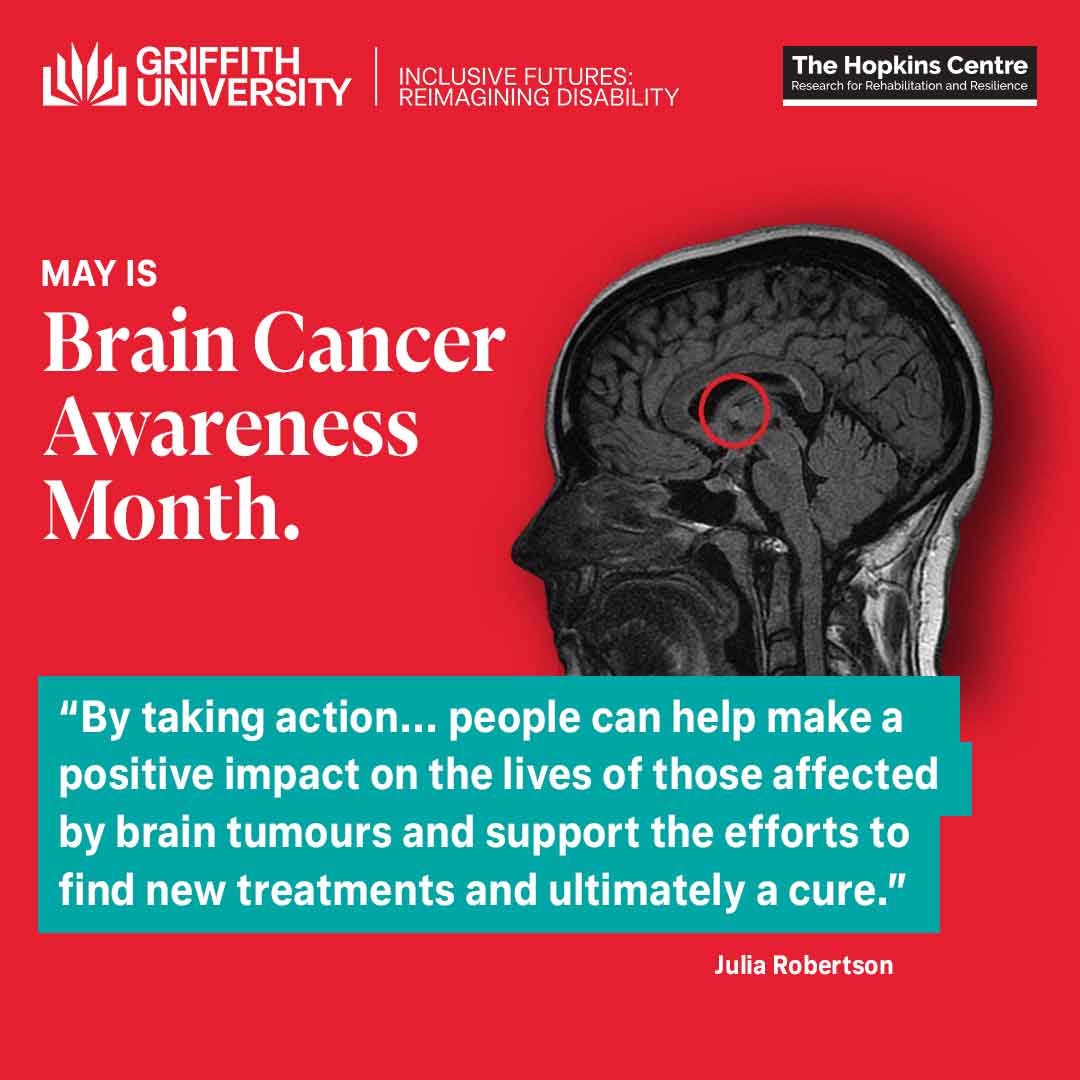BLOG: Brain Tumour Awareness Month 2023 with Julia Robertson
May is Brain Tumour Awareness Month (#BTAM) – a time where we come together in support of brain cancer survivors, providing empowerment, spreading hope and amplifying the voices of the brain cancer community.
To help us in this aim, we asked Brain Tumour survivor, researcher and Disability Advocate, Julia Robertson, about her journey.
Over five (5) weeks of May, 2023, Julia will be blogging her thoughts and reflections on the topic with us here.
Stay tuned each Monday in May for a new post.
Week 1
Q: What is important to you about Brain Tumour Awareness Month?
Brain tumour awareness month (BTAM) is an important time of year for many people around the world. It is a time to raise awareness about the impact of brain tumours on individuals and their families, as well as the need for research, support, and improved access to care. This blog post will explore why BTAM is so important and what it means to those affected by this devastating disease.
First and foremost, BTAM is an opportunity to educate the public about the prevalence and impact of brain tumours. Brain tumours can affect anyone, regardless of age, gender, or lifestyle. They can develop in any part of the brain and can cause a wide range of symptoms, including headaches, seizures, cognitive impairment, and personality changes[1]. By raising awareness about brain tumours, we can help people understand the importance of early detection, treatment, and support for those affected.

BTAM is also important because it brings attention to the need for research and funding. Despite the fact that brain tumours are 9th leading cause of cancer death in Australia[2], they receive a fraction of the funding and research that other cancers do. This means that treatment options for brain tumours are limited, and many people do not receive the care they need. By raising awareness and advocating for increased research and funding, we can help improve outcomes for those affected by brain tumours.
Another important aspect of BTAM is the opportunity to connect with others who are affected by the disease. For individuals with brain tumours and their families, the diagnosis can be isolating and overwhelming. By coming together during brain tumour awareness month, we can create a sense of community and support for those who are facing this difficult journey. We can share our experiences, offer encouragement, and advocate for each other to ensure that everyone has access to the care and resources they need.
Finally, BTAM is a time to celebrate the courage and resilience of those affected by brain tumours. Despite the challenges they face, individuals with brain tumours and their families continue to persevere, find hope, and inspire others. By shining a light on their stories and accomplishments, we can honour their strength and encourage others to keep fighting for better outcomes and a brighter future.
In conclusion, BTAM is an important time of year for many reasons. It is a time to raise awareness, advocate for funding and research, connect with others, and celebrate the courage of those affected by brain tumours. By coming together during this month, we can make a difference and create a brighter future for everyone affected by this disease.
Week 2
Q: Is there a brain tumour fact that you'd really like people to know? Or maybe a fact that always surprises people?
There is a brain tumour fact that I think is important for people to know. It is that brain tumours are the leading cause of cancer-related deaths in children and young adults under the age of 20[3]. This is a surprising fact for many people because they assume that cancer is more common in older adults. However, brain tumours can affect people of all ages, and the impact on children and young adults can be especially devastating.
Another fact that may surprise people is that not all brain tumours are cancerous[4]. While some brain tumours are malignant and can spread to other parts of the body, others are low-grade[5] (previously called benign) and do not spread. However, even low-grade brain tumours can be life-threatening if they grow in size and compress surrounding brain tissue. Therefore, it is important for individuals with any type of brain tumour to receive appropriate care and monitoring.
It is also important to note that symptoms of brain tumours can vary widely depending on the location and type of tumour. While some symptoms may be subtle, others can be more pronounced and may include headaches, seizures, vision problems, and changes in cognitive or motor function. If you or someone you know is experiencing persistent or unusual symptoms, it is important to seek medical attention to determine the cause and receive appropriate care.
Overall, it is important for people to be aware of the impact of brain tumours and to understand that they can affect anyone, regardless of age or lifestyle. By raising awareness and advocating for research, funding, and support, we can work towards improving outcomes for those affected by this devastating disease.

Week 3
Q: How has your experience been positive in your life?
There have been positive changes in my life as a result of my experience. The experience of facing a life-threatening illness has led to a greater appreciation for life, a deeper sense of gratitude, and a stronger connection to others. I have also gained a greater sense of resilience and inner strength. As I have navigated the challenges of recovery and have developed new skills and interests.
I have become a patient and disability advocate. I raise awareness about brain tumours and acquired brain injury, using my experience to help others who may be going through a similar journey. By sharing my story and raising awareness, I can help to direct research, promote understanding, and support efforts to find new treatments, supports and ultimately a cure.
I view my life beyond 2011 as an opportunity do what I can to prevent others from going through the same struggles and hurdles that my family and I encountered throughout this rollercoaster. This has driven my study and research interests, as well as my work. I started a Bachelor of Science in 2014 with the lofty goal of studying neuroscience and perhaps finding a detection method or cure for brain tumour. When the damage to my brain did not allow for that to progress, I sidestepped into a Bachelor of Psychological Science so that I would be better armed to help others navigate the unique space that is life with a brain tumour. This led me to research as a way of impacting more people on a much bigger scale than I could possibly hope to help on an individual basis. From there I started a Master of Global Health with a view to finding ways to fix the gaps in healthcare and policy that so many people fall through.

While I am driven in my purpose and my direction, I have also learned to be flexible, to have backup plans and be able to step sideways rather than throwing in the towel and giving up when things don’t work out the way I had ‘planned’. I’ve learned that it is okay, and sometimes necessary to hit pause. Sometimes it’s time to put the thing down and walk away. The important thing is moving forward, it doesn’t have to be warp speed, snails still get where they are going.
Of course, it is important to acknowledge that not all experiences with brain tumours are positive and that every person's journey is unique. I have been touched by so many people around the world living with brain tumour that I am driven to continue fighting as long as I am able. It is a personal loss every time we lose another person to a brain tumour. However, for some, the experience of facing and overcoming a brain tumour can lead to positive changes and new opportunities in their lives.
I would never have imagined in my life before the brain tumour that I would be where I am now, doing the things I am doing. It was not ever on my radar.
Week 4
It’s common and reasonable to feel powerless against a disease like brain cancer. Still, there are plenty of ways to have a positive impact. Can you suggest 3 ways people can help those fighting brain tumours or help the cause of BTAM/finding a cure?
There are many ways people can help those fighting brain tumours or support the cause of BTAM.
Here are three suggestions:
- Donate to a brain tumour charity or research organisation. There are several organisations dedicated to raising awareness, providing support, and funding research into brain tumours. Donating to one of these can help make a difference in the lives of those affected by brain tumours and support efforts to find new treatments and ultimately a cure.
- Volunteer your time or skills to a brain tumour organisation. Many organisations rely on volunteers to help with fundraising, event planning, and other activities. If you have skills or expertise in a particular area, such as marketing, social media, or event planning, consider offering your time to help an orgnanisation working with brain tumour survivors.
- Spread awareness about brain tumours and Brain Tumour Awareness Month. One of the most important things people can do is to help raise awareness about the impact of brain tumours and the need for increased research, funding, and support. Sharing information on social media, hosting an event, or talking to friends and family can all help spread the word about this important cause.

By taking action in any of these ways, people can help make a positive impact on the lives of those affected by brain tumours and support the efforts to find new treatments and ultimately a cure.
Here are some organisations Julia suggests people could connect with if they want to support the cause of BTAM:
- Cure Brain Cancer Foundation (Previous Cure For Life Foundation )
- Peace of Mind Foundation
- Mark Hughes Foundation
- Charlie Teo Foundation
- Brain Tumour Alliance Australia
- Brain Child
Week 5
You're so resilient for having gone through this journey and survived your tumour. What advice do you have to those going through the same journey OR what advice would you give to that younger version of yourself, about the journey of being a brain-tumour survivor?
Here is some advice that may be helpful for those going through a similar journey:
- Seek out support: Going through a brain tumour diagnosis and treatment can be an overwhelming experience. It is important to surround yourself with a supportive network of family, friends, and healthcare professionals who can provide emotional and practical support.
- Take care of yourself: It is important to take care of yourself during and after treatment. This can include eating a healthy diet, staying physically active as much as possible, getting enough rest and sleep, and practising self-care activities that help to reduce stress and promote relaxation.
- Be patient with yourself: Recovery from a brain tumour can be a long process, and it is important to be patient and kind to yourself. Set realistic goals, take things one day at a time, and celebrate small victories along the way.
- Advocate for yourself: It is important to be an active participant in your own healthcare and treatment decisions. Ask questions, express concerns, and advocate for yourself to ensure that you are receiving the best possible care.
- Connect with other survivors: Connecting with other brain tumour survivors can be a valuable source of support and encouragement. Consider joining a support group or online community to connect with others who have gone through a similar experience.
To my younger self or anyone going through the rollercoaster of living with a brain tumour, know that it is a challenging experience, but it is possible to manage it with the right support, mindset, and determination. Remember to take care of yourself, stay positive, and keep pushing forward, one day at a time. You are not alone in this journey, and there is hope.
One of the greatest things I ever did was to read “A Letter from your brain” Written by Stephanie St Claire. It is available online and even has been read out loud on Youtube. I still read it from time to time to remind myself that my brain is where I live, where my life is and without it, I cannot exist. We are dependent on each other; we cannot go forward as enemies.
Be gentle with yourself.
.png)
In our final #BTAM2023 blog we talk to Professor Tamara Ownsworth, Research Director, The Hopkins Centre about the Making Sense of Brain Tumour (MAST) program.
On average each day, 6 Australians are diagnosed with brain and other central nervous system cancers and 4 will die from such diseases. Brain tumour broadly encompasses three subtypes: benign (non-malignant) tumor, lower-grade glioma (less aggressive initially, but risk of progression or recurrence over time) and high-grade glioma (malignant). Compared to other cancers, people with Brain Tumour typically face greater disease burden and have the largest lifetime cost per person.
Individuals with a brain tumour, of any kind, experience considerable stress related to their diagnosis and complex neurocognitive #impairments which significantly impact their mental health and that of their caregivers. Yet, there is minimal investment directed towards psychosocial care and a lack of research on ways to improve the well-being of these individuals and their families.
In a major step to address this gap, Griffith University and Cancer Council Queensland (CCQ) collaborated in 2010-2013 to conduct the first clinical trial of psychosocial support for people with brain tumour; the Making Sense of Brain Tumour (MAST) program.
Delivered face-to-face in people’s homes, this 10-session program (1 session p/w) was found to significantly improve mental health and quality of life (QoL) for people with brain tumour relative to standard care. Yet, barriers associated with face-to-face therapy in a clinic (e.g. transport, distance, debilitating symptoms) restrict people’s ability to access the MAST program. We therefore trialled the feasibility of remote delivery of the MAST program through the use of video conferencing (Zoom) Tele-MAST with Hopkins Ambassador Julia Robertson.
Funded by a National Health and Medical Research Council (NHMRC) Partnership Grant with Cancer Council Queensland, this program was successful, and was found to be four times more likely to reduce levels of depression, and also improved quality of life.
Due to the established effectiveness of Tele-MAST, we are now evaluating the nationwide implementation of our program through a MRFF Brain Cancer Survivorship Grant. People living anywhere in Australia who have access to an appropriate device and internet can participate.
People interested in taking part are encouraged to read more about the study and express their interest through the following link.
We are recruiting until August 2023.
https://lnkd.in/gxAgxaSH
[1] Brain cancer: Stages, symptoms, treatments & research. ACRF. (2023, March 1). Retrieved April 3, 2023, from https://www.acrf.com.au/support-cancer-research/types-of-cancer/brain-cancer/
[2] Cancer Australia. (2019, December 18). Brain cancer in Australia statistics. in Australia statistics | Cancer Australia. Retrieved April 3, 2023, from https://www.canceraustralia.gov.au/cancer-types/brain-cancer/statistics
[3] Thorbinson, C., & Kilday, J. P. (2021). Childhood Malignant Brain Tumors: Balancing the Bench and Bedside. Cancers, 13(23), 6099. https://doi.org/10.3390/cancers13236099
[4] Brain cancer: Stages, symptoms, treatments & research. ACRF. (2023, March 1). Retrieved April 3, 2023, from https://www.acrf.com.au/support-cancer-research/types-of-cancer/brain-cancer/
[5] Grades of brain and spinal cord tumours. Cancer Research UK. (2023, February 1). Retrieved April 11, 2023, from https://www.cancerresearchuk.org/about-cancer/brain-tumours/grades

